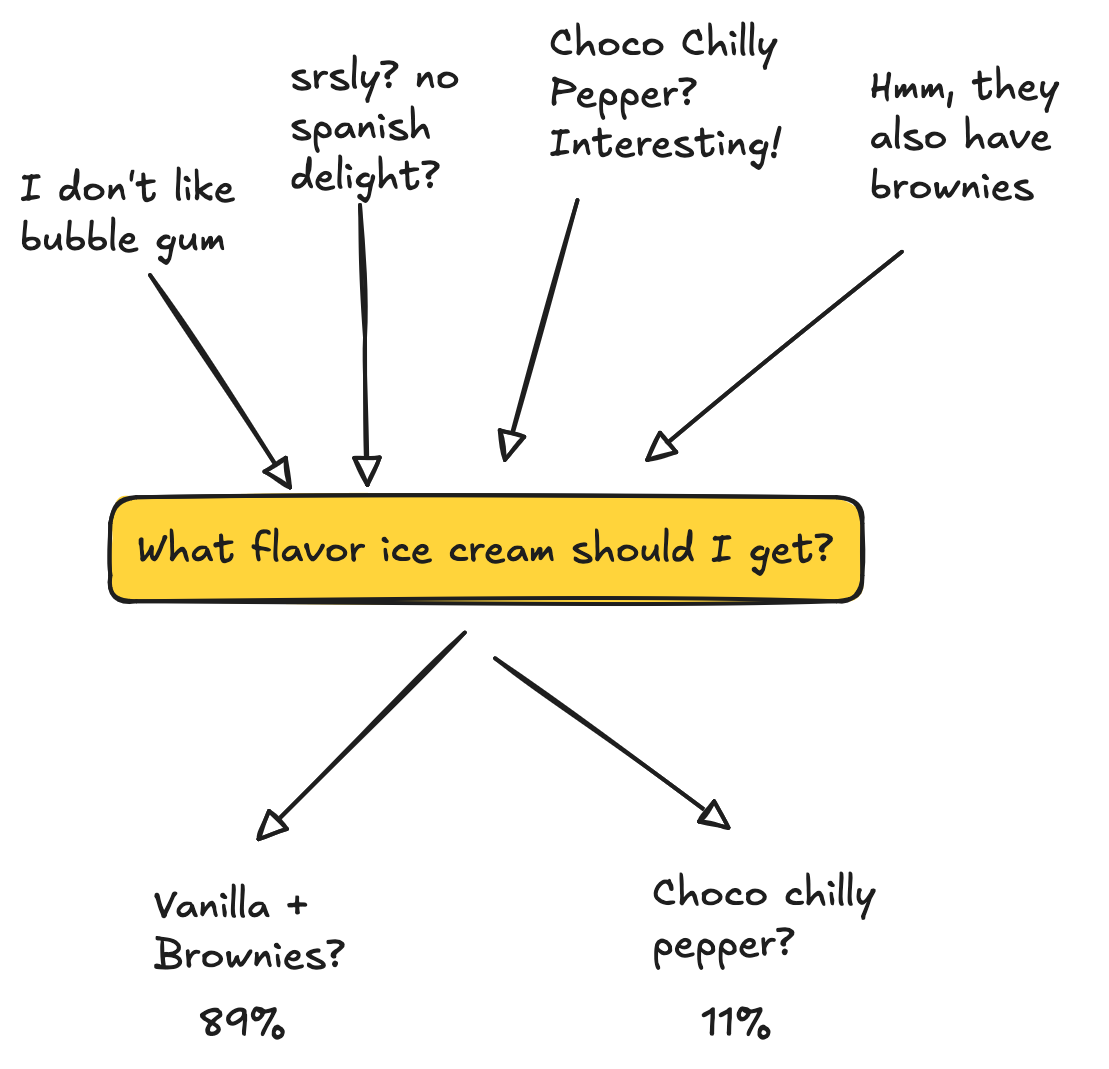This post is not a theoretical or generalized framework for decision-making! It's how I have been thinking about decision-making and modelling my own mental model.
What is a decision? A decision is a choice or judgment that you make after considering various possibilities. Well, at least that's the dictionary definition.
I fundamentally see the process of decision-making as a complex process that involves multiple factors. To keep it simple, my decision of carrying an umbrella is influenced by the weather forecast and whether or not I like getting drenched in the rain.
The decision of whether to carry an umbrella depends on the weather forecast and your tolerance for getting wet. The outcome is either "Yes" (carry an umbrella) or "No" (don't carry one).
For a lot of people, including myself, who face trouble with decision-making, it's not the process that is hard—it's usually:

Too Many Outputs
A classic example of this is choosing which ice cream flavor you want! The problem here is not whether you want or don't want ice cream, but more about which of the 100 flavors will make you happy.
The decision about which ice cream flavor to choose depends on things like what's available and your personal biases. The possible outcomes are Vanilla, Chocolate, Spanish Delight, and so on, up to Ice Cream Flavor 98 or Choco Chilly Pepper.
FYI, Spanish Delight is the best ice cream flavor, mic drop.
Input Overload
Take the ice cream example again but with just two choices: chocolate and vanilla.
The decision about which flavor you pick (chocolate or vanilla) depends on your past experiences, your current mood, what influences you, what flavors are available, and your personal biases.
The number of inputs (x1, x2, ..., xn) can clog your decision-making process, especially if the decision has a lot of long-term consequences!
But for our case, just get both flavors and move on! Or, just get vanilla if they serve brownies too.
Unknown Outcomes
Your decision-making process can also feel like a black box! You don't know what will happen! Your brain might also consider the opportunity cost and wonder about the second-order effects of your initial outcome. For example, will choosing strawberry make me happy?
Minimize Clogging Your Brain
Eliminate Outputs
I don't want any other flavors—just give me Spanish Delight! Or, if I'm feeling adventurous, I ask the ice cream guy how good the Choco Chilly Pepper is and just live with that choice. For complex decisions, I use this approach of elimination to remove the choices I already know won't sustain or have less significant consequences.
Eliminate Inputs
If they have brownies, pick vanilla. If they don't, pick chocolate.
However, this approach can have large consequences for complex decisions that require a lot of thought. It's advisable to think through all your inputs before eliminating any; you don't want to eliminate the inputs that have a lot of weight toward generating a major result with greater second- or third-order impacts!
Complex Decisions & First and Second-Order Effects
For many of us, everyday complex decisions might be composite functions. For example, a general decision of whether or not to pursue Engineering could be framed as:
The decision about whether to pursue engineering depends on three main factors: x, y, and z.
Where:
- x is determined by your education, experience, and talents
- y is determined by job market trends and industry growth
- z is determined by your hobbies, intrinsic motivation, and work-life balance
Each of these inputs might also be weighted, meaning that y might influence the decision more than x or z.
Foundationally, this is how I see first- and second-order thinking too. Decisions made when you decided about your education can influence your decision about engineering.
Your decision about your education (which depends on factors x₁, x₂, ..., xₙ) can influence your decision about engineering (which depends on x, y, z).
A general mental model in my brain is:
Think of it as a function that takes each input (x₁, x₂, ..., xₙ), multiplies it by a weight (w₁, w₂, ..., wₙ), and combines them. Each input can itself be a simple value, another function, or a combination of things.
Dealing with Time-Bound Decisions
Easy! Eliminate unnecessary or low-weight inputs and functions, define if time has a maximizing or minimizing weight, eliminate outputs you think are wrong, and live with your decision!
Making This More Complex!
Sometimes, instead of weighted inputs, I think in terms of partial derivatives to eliminate and determine outputs, especially when it comes to time-bound decisions. These are generally good for when you already have a bias!
My choice of engineering was a direct influence of my sensitivity to math and computers, and my thesis that I will find more opportunities in this field as my interest in engineering, computers, or math increases. That's the second derivative! Another way to think of first- and second-order outcomes!
TL;DR
You do all of this without thinking about all these complications, and you'll never need to think of this mathematically! The only two cents I have from this post are: input and output elimination and live with your choices. No one else is going to make decisions for you!